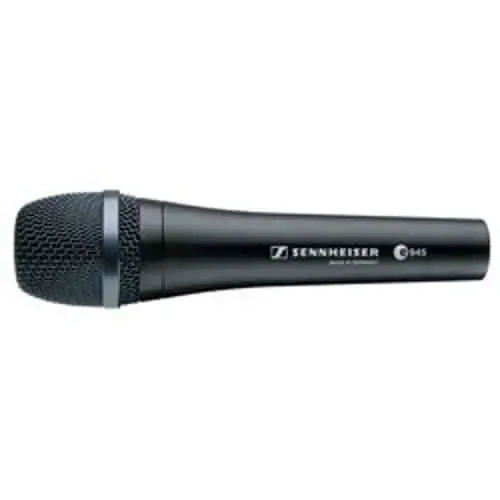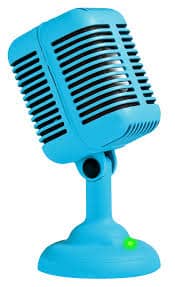While the emphasis on microphones these days may be on Recording mics because of the popularity of Home Recording, without good live performance, the recordings won’t matter too much. Mics are engineered with wide frequencies for lower male and softer higher female frequencies built-in. What are the best Dynamic Vocal Mics?
Dynamic cardioid polar pattern mics with a strong proximity effect including a flat response across the entire range of frequencies that it responds to & the ability to handle high Sound Pressure Levels (SPL) rejecting background like Shure SM58-LC-Heil Sound PR35-Sennheiser e945 Dynamic Vocal Mics
Typically general working microphones for live vocals are Dynamic microphones for several different reasons. Dynamic mics in most cases have a lower frequency range but sound warmer than the Condenser mic that is used in studios. Condenser mics have a higher frequency range and a brighter sound but are fragile in construction.
High-Frequency Microphone
Some Dynamic mics have their own frequencies that are built-in and engineered to enhance certain types of live music. They are versatile and can be applied to work with different applications on stage, miking amps, and other instruments. The Cardioid Dynamic mics have the ability to handle high Sound Pressure Levels (SPL) and reject background noises that are vital on stage.
This specification points to the maximum volume in dB that a microphone can handle without introducing distortion. And since volume on different microphones varies per frequency (for example: (louder at lower frequencies or vice versa), this specification usually has an @ frequency label.
Dynamic mics don’t have electronics inside to overload as Condenser mics do. This allows them to handle as much as 150dB to 180dB, which are the extreme levels you won’t experience under normal live situations.
There is always a chance to encounter distortion, but there is less with using a Dynamic microphone. With all the uncontrolled sounds that are happening on a stage during Live play, the use of the Dynamic directional mic has always been the choice for musicians.
Best Mic For Baritone Vocals
Dynamic Mics are used by the male vocalist for Live concert plays. In some examples, you hear differences in fullness and frequency. The Sure SM58 has all the working nuts and bolts you would need in a Live Play situation. I’ve had mine for many years now and it’s been dropped more than a few times.
Besides the durability, the SM58 mic has Cardioid polar patterns that cut or lessen the noise in the background of the vocalist on stage. Dynamic mics have a rugged construction which has been mentioned here a few times and are apt to hold up better for play on the Live stage.
Recording Engineers give the SM58 two thumbs up for everything this represents since it was put on the market in the ’60s and used by Big Vocalist in Rock like Roger Daltry from The Who. MikingDesign.com through Amazon has the Shure SM58-LC Cardioid Dynamic Vocal Microphone
The frequency response of the SM58 is 50 to 15,000 Hz, a pretty high range for a microphone. This covers the entire human voice and most strings as well, with a surprisingly very low-frequency pickup for a mic. It has an excellent gain-to-feedback ratio meaning you can turn it up very well without having a lot of feedback, something found with some other microphones in the market.
Frequency response tailored for vocals, with brightened midrange and bass roll-off to control proximity effect. This means that with most Dynamic microphones the closer you get the lower or bassier the frequencies tend to be. This is what is referred to as the Proximity effect. The Sure 58 has a roll-off to help control that effect and smooth it over so it doesn’t stand out. The Shure SM58 S version also comes with an on/off switch that comes in handy in Live vocal settings.

For a male vocalist who is hugging the mic on stage, the bass frequencies are lighted up and the mid-range frequencies will brighten up for better sound vocals. This would be my choice for the Best Dynamic Live-Vocal Mic for a Male Vocalist.
As a vocalist you want your voice to sound as clean and crisp as possible but still sound a special way that you want it. Pick out mics by testing some different ones in different price ranges. Speak directly into the mic. Stay close to the mic 5 to 15 centimeters. Don’t get too close or what’s called “eating the mic” that will sound unnatural and pick up breathing sounds. The SM7B delivers the warmer lower frequencies that are needed by a female vocalist.
Also capturing the high-pitched frequencies that are lost and not audible. The right mic for your voice can only be decided by you through experimenting with different ones but start with proven ones like these.
If you want your vocals to stand out and be heard, the Shure SM58-LC Cardioid Dynamic Vocal Microphone is built to make it happen. It’s a high-output, super-cardioid dynamic microphone designed for professional sound reinforcement and project studio recording. This has made it a leading choice among vocalists and touring musicians worldwide.
The Beta 58A maintains a true super-cardioid pattern throughout its frequency range (50Hz-16kHz) and a shaped frequency response that is ideal for close-up live vocals. You can hold this mic in your hand while performing and moving on stage. Used by alto R&B/rock singers.
Best Mic For Female Vocals
For female vocals, the Beta 58 is actually pretty usable. The Beta 58 has an upper midrange that can either be interpreted as helping the vocal “cut,” or just making it plain harsh, depending on how your voice is.
Those who are not too happy with the rounder sound and bass emphasis of the SM58 found themselves at home with the Shure Beta 58A’s clearer sound. Try both.
Another Dynamic mic with clear sound and lower smoother frequencies is Heil Sound PR35 – Cardioid Dynamic. Another is the AKG P5 Pro Audio mic, which sells for less than $100.00. This microphone is popular and economical and used by female/male vocalists. Many of the high ratings are from female singers who prefer its super-cardioid pattern, which allows them to play an instrument and sing at the same time, with less bleeding compared to regular cardioid mics. Durability is also well appreciated, with some even saying that you can use some of these mics to hammer a nail.
The Sennheiser e945 for female pop vocalists with good mic technique. It is a solid, well-built, good-value microphone designed for touring and heavy use. It has a frequency response that suits pop vocals, and although (depending on the vocal style) it can get a bit harsh and lively at 4kHz and 10kHz, this can easily be rectified with a little bit of EQ and a multiband. Its polar pattern is tight and great for reducing unwanted spills down the vocal channel. Handling noise is non-existent.
Even though most people admit that mics have to be chosen individually, out of all the vocal Dynamic mics Sennheisers models, e935 has probably the most successful reviews – it has the sweet spot, that’s easy to work with and according to its reviews, it works for almost everyone!

It doesn’t matter whether you are a high-pitched female singer, a bassy baritone, or a tenor, or whether you are buying it for your 10-year-old kid, this mic can still give you an amazing performance on a wide frequency range. This mic is very affordable and would be an invaluable tool for any musician on stage, singing vocalist, male or female.
The mics listed here are inexpensive but good-quality vocal microphones that are standard in every roadie’s arsenal of equipment. All vocalists should experiment with different Dynamic mics that fit what sound they are chasing. The Best Mic for Live Performance can definitely fit your budget.
JimGalloway Author/Editor

MikingDesign.com

